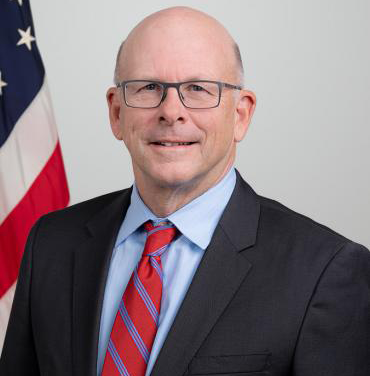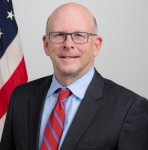In September, Jim Jones, former EPA employee and member of the Reagan-Udall Expert Panel for Foods, became the first FDA Deputy Commissioner for Human Foods. He is tasked with reorganizing the agency to develop better coordination among the multiple departments involved in the regulation of human foods in the U.S., as well as allocating resources to better protect consumer.
Jim Jones, Deputy Commissioner for Human Foods at FDA, to deliver the Keynote Presentation at the Food Safety Consortium Conference October 20-22, Washington DC. Attendees will gain valuable perspectives on regulatory shifts, emerging challenges, and collaborative opportunities shaping the landscape of food safety and compliance. Discover how the new Deputy Commissioner’s strategic vision will drive innovation, enhance public health outcomes, and foster trust within the food industry. FoodSafetyConsortium.org
At the EPA, Jones was a principal architect of the 2016 overhaul of the Toxic Substances Control Act and was also responsible for decision-making related to the regulation of pesticides and commercial chemicals. He also led several national sustainability programs, including the EPA’s Environmental Preferable Purchasing Program and the Presidential Green Chemistry Awards Challenge. Here, he shares his vision and goals for a unified Human Foods Program (HFP) and why he pursued the opportunity to lead this new program.
What are your goals in your new position and what attracted you to the role of deputy commissioner for human foods?
Jones: People often want to know why I came to the FDA. I had a long career in government service and after some time in the private sector, I missed being involved in really meaningful work that affects the life of every American. I also came to the FDA because I believe in Commissioner Califf’s proposal for a unified Human Foods Program. Having been part of the Regan Udall Foundation’s evaluation of the foods program, I had the opportunity to understand what was working, and what was not working at the FDA. During this evaluation we realized that fundamentally the challenges within the agency were structural and not attributed to staffing. Our job, therefore, is to improve our internal structure so that we better utilize the talent we have to carry our mission more efficiently and effectively.
The proposal for a unified Human Foods Program focuses on the wellness of U.S. consumers by recognizing that access to safe, nutritious food is key to improving the health of our nation. This proposal is a major reorganization of how our food programs are structure and how they will function day to day. Over the long term, we believe it will support the transformation of how the FDA regulates food.
As the first Deputy Commissioner for Human Foods, I am deeply committed to upholding and executing this vision. As we work to implement the proposed HFP, I am committed to building on the vision laid out in the FDA Food Safety Modernization Act. Through our reorganization we will be elevating the importance of nutrition, strengthening state partnerships, and embracing innovative food and agricultural technologies that will allow us to supply the nation – and the globe – with ample safe and nutritious food in the decades ahead.
But we can’t do this alone. In fact, one of my main objectives that I want to carry throughout my tenure at FDA is strengthening our relationships across the many groups that we work with. I am starting this process off by meeting with as many of our stakeholders as I can. I have made a commitment to listen and learn from those who grow, produce, manufacture, and sell foods, from our state regulatory partners, and also those in academia and consumer and health advocates. Leveraging the expertise across our stakeholders is how we will make progress. I am encouraged by the work that has already been done—and I am excited about the possibilities for building on this foundation to bring about broad, systematic changes to how we protect the food supply and help improve the nutrition of consumers.
During your work on the Reagan-Udall panel, what were some of the challenges of the current FDA system that surprised you and that you felt could be most readily addressed?
Jones: We’ve heard time and time again that the current structure is too fragmented, and that the agency needs clearer decision-making and priority-setting pathways over its human food activities. Consolidating human food activities under a single leader who reports directly to the Commissioner unifies and elevates the program while removing redundancies, enabling the agency to oversee human food in a more effective and efficient way. We’ve also heard that the program is challenged since it doesn’t have authority over inspectional resources. Our plan will give the HFP clear authority over resource allocation so it can best prioritize risks and manage foods resources.
The report mentioned lack of a clear vision and mission for human foods program; what is the vision and mission you would like to adopt and instill in the program to guide its work?
Jones: We want to move forward with an approach that puts prevention at the heart of what we do. As I laid out in my statement earlier this year, to protect public health we have prioritized preventing foodborne illnesses, enhancing food chemical safety, and improving nutrition. To help prevent foodborne illness outbreaks, we are removing structural barriers and supporting integration across the agency’s food programs. This will enhance our ability to identify contaminant risks earlier and intervene more quickly and in a more targeted way.
To improve nutrition in our proposal, our dedicated Nutrition Center of Excellence will centralize coordination and provide strategic leadership. This will elevate, strengthen, and expand our nutrition work. We also are proposing to have one office dedicated to food chemical safety, dietary supplements, and innovation. This dedicated office will create a framework for our post-market safety review of previously authorized chemicals used in food to complement our robust premarket safety evaluations.
Based on your experience with the EPA and now the FDA Human Foods Program, what are some of the benefits to having distinct public agencies overseeing specific areas of public health, and where do we need more collaboration to better protect the public?
Jones: There are skills developed in regulatory agencies with a public health orientation that are very transferable. For example, understanding that meaningful public engagement before you decide how to regulate leads to more informed and timely decisions, but also sustainable decisions. You also understand the critical role played by Congress, as well as how to manage issues within the Executive Branch. These are all very important in getting work done and aren’t unique to any one Agency.
Elevating the importance of nutrition is a key focus of the proposed HFP model. What are some of the current challenges in fulfilling the dual role of ensuring safe food while also ensuring or providing better access to nutritious food?
Jones: If you think about the overall goal of having a food supply that supports health and wellness, our food safety and nutrition initiatives go hand in hand. We want to prevent illnesses that can occur due to contamination as well as those that occur because of poor nutrition.
Most people in the U.S. do not eat enough fruits, vegetables, dairy, whole grains, and healthy oils, and consume too much saturated fat, sodium and added sugars. Our goal is to ensure U.S. consumers have greater access to healthier foods and nutrition information to identify healthier foods more easily. This work supports public health by reducing preventable illnesses through improved nutrition is among our highest priorities because it has the greatest potential to reduce diet-related chronic diseases that are the leading cause of death and disability in the U.S.
In order to elevate and strengthen the FDA’s nutrition portfolio, the HFP includes a proposal to create a Nutrition Center of Excellence that will enable the FDA to focus even more strategically on nutrition policies and initiatives.
We have a food safety system that encompasses many agencies on the federal, state, tribal nation, and county levels, do you see areas for improvement in helping all these agencies work more cooperatively.
Jones: Food safety is a shared responsibility that involves food producers, distributors, manufacturers, and retailers. Close coordination among the FDA, the Centers for Disease Control and Prevention and international, state, local, tribal, and territorial regulatory partners, public health, and agriculture departments is crucial to finding, stopping, and preventing foodborne illness outbreaks.
To foster the health and wellness of all U.S. consumers, the proposed HFP will continue to expand upon tools to enhance our food safety work. For example, we will prioritize partnerships through the proposed new Office of Integrated Food Safety System Partnerships, which will be a one stop shop for local, state, tribal, and territorial food safety partnerships.
Each of the agencies above have mentioned challenges in attracting and nurturing new food safety professionals, including auditors and inspectors. Do you see opportunities to improve recruitment and retention in the profession through the Unified Human Foods Program?
Jones: As always, the FDA is eager to recruit and retain talented federal employees. With the reorganization of the new HFP, along with available resources, we hope to attract top talent to assist with our food safety goals.








